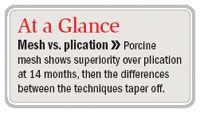Article
Differences in vaginal prolapse repair treatment wane at 2 years
With a median 2 years of follow-up, anterior repair with porcine skin collagen mesh still looks better than plication alone, but not dramatically better, and the difference could lessen with longer-term follow-up.
Udine, Italy-Long-term results can often change the picture painted by comparative studies. That lesson came home in a long-term study of prolapse repair with porcine mesh versus plication alone.

For women, the lifetime risk of having prolapse and consequent surgical repair is high (about 11%), but the reoperation rate is even higher (about 30%), and the interval between repairs decreases with each successive repair, "so we have the best chance to treat our patients with the first procedure we are offering to them," said first author Ervin Kocjancic, MD.

At the beginning of the study, 206 patients were enrolled. Of these women, 100 received the porcine mesh; 106 did not. The groups were comparable in age, symptoms, dyspareunia, and other demographic factors, as well as in the severity of pelvic organ prolapse and the rate of associated procedures, including vaginal hysterectomy and posterior repair.
At 6 months, there was no difference in effectiveness between the procedures. However, at 14 months, the rate of unsatisfactory outcomes was 7% for the porcine mesh group and 19% for plication alone.
Also at that time, no significant difference between the rates of stress urinary incontinence was reported, but urge incontinence was significantly lower in the porcine mesh group. Both groups had significant reductions in dyspareunia, but the porcine mesh group had a significantly higher reduction.
Only two new surgeries were required in the porcine mesh group: one graft removal and one hysterectomy. Three new surgeries were needed in the plication group: one sacrospinous fixation and anterior repair, one posterior intravaginal slingplasty, and one periurethral injection.
At 24 months, the patients who received porcine mesh were still doing better than were those who had plication alone, and most of the women reported that they were satisfied with their condition. But of the 176 patents who could be evaluated, the difference between unsatisfactory outcomes narrowed, with a rate of 11% in the porcine mesh group and 23% in the plication group (p=.04). Dr. Kocjancic suggested that the lack of lateral support may be a reason for the narrowing difference.
The ultimate goal of prolapse repair, according to Dr. Kojancic, is not only to repair damaged tissue, but also to replace or regenerate that tissue by sustaining it on some form of matrix. The new biomaterials have great potential in that role.
Newsletter
Stay current with the latest urology news and practice-changing insights — sign up now for the essential updates every urologist needs.















